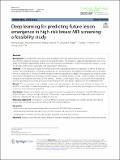Deep learning for predicting future lesion emergence in high-risk breast MRI screening: a feasibility study
Author(s)
Burger, Bianca; Bernathova, Maria; Seeböck, Philipp; Singer, Christian F.; Helbich, Thomas H.; Langs, Georg; ... Show more Show less
Download41747_2023_Article_343.pdf (3.326Mb)
Publisher with Creative Commons License
Publisher with Creative Commons License
Creative Commons Attribution
Terms of use
Metadata
Show full item recordAbstract
Abstract
Background
International societies have issued guidelines for high-risk breast cancer (BC) screening, recommending contrast-enhanced magnetic resonance imaging (CE-MRI) of the breast as a supplemental diagnostic tool. In our study, we tested the applicability of deep learning-based anomaly detection to identify anomalous changes in negative breast CE-MRI screens associated with future lesion emergence.
Methods
In this prospective study, we trained a generative adversarial network on dynamic CE-MRI of 33 high-risk women who participated in a screening program but did not develop BC. We defined an anomaly score as the deviation of an observed CE-MRI scan from the model of normal breast tissue variability. We evaluated the anomaly score’s association with future lesion emergence on the level of local image patches (104,531 normal patches, 455 patches of future lesion location) and entire CE-MRI exams (21 normal, 20 with future lesion). Associations were analyzed by receiver operating characteristic (ROC) curves on the patch level and logistic regression on the examination level.
Results
The local anomaly score on image patches was a good predictor for future lesion emergence (area under the ROC curve 0.804). An exam-level summary score was significantly associated with the emergence of lesions at any location at a later time point (p = 0.045).
Conclusions
Breast cancer lesions are associated with anomalous appearance changes in breast CE-MRI occurring before the lesion emerges in high-risk women. These early image signatures are detectable and may be a basis for adjusting individual BC risk and personalized screening.
Relevance statement
Anomalies in screening MRI preceding lesion emergence in women at high-risk of breast cancer may inform individualized screening and intervention strategies.
Key points
• Breast lesions are associated with preceding anomalies in CE-MRI of high-risk women.
• Deep learning-based anomaly detection can help to adjust risk assessment for future lesions.
• An appearance anomaly score may be used for adjusting screening interval times.
Graphical Abstract
Date issued
2023-06-07Department
Massachusetts Institute of Technology. Computer Science and Artificial Intelligence LaboratoryPublisher
Springer Vienna
Citation
European Radiology Experimental. 2023 Jun 07;7(1):32
Version: Final published version